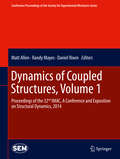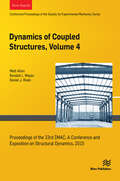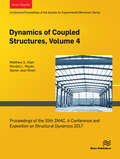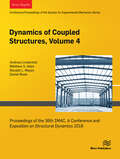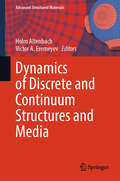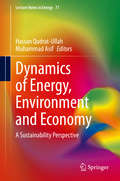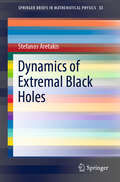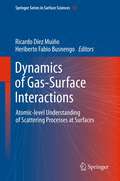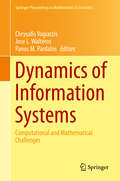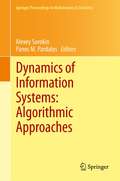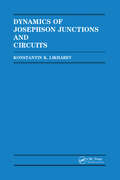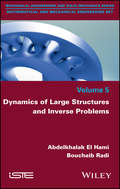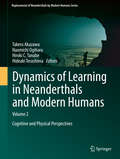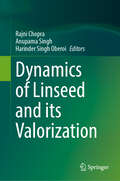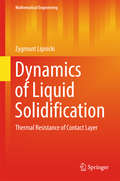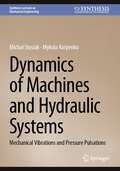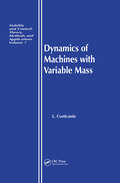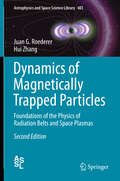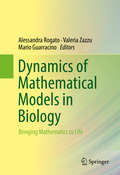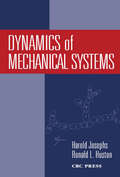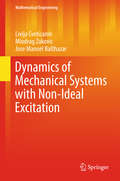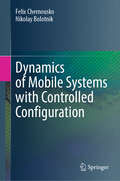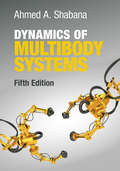- Table View
- List View
Dynamics of Coupled Structures, Volume 1
by Matt Allen Daniel Rixen Randy MayesThis first volume of eight from the IMAC-XXXII Conference, brings together contributions to this important area of research and engineering. The collection presents early findings and case studies on fundamental and applied aspects of Structural Dynamics, including papers on: Linear Systems Substructure Modelling Adaptive Structures Experimental Techniques Analytical Methods Damage Detection Damping of Materials & Members Modal Parameter Identification Modal Testing Methods System Identification Active Control Modal Parameter Estimation Processing Modal Data
Dynamics of Coupled Structures, Volume 4: Proceedings of the 33rd IMAC, A Conference and Exposition on Structural Dynamics, 2015
by Daniel J. Rixen Matt Allen Randall L. MayesDynamics of Coupled Structures, Volume 4. Proceedings of the 33rd IMAC, A Conference and Exposition on Balancing Simulation and Testing, 2015, the fourth volume of ten from the Conference brings together contributions to this important area of research and engineering. The collection presents early findings and case studies on fundamental and applied aspects of Structural Dynamics, including papers on: Substructuring and the Ampair Wind Turbine Test Bed Experimental Dynamic Substructuring Reduced Order Models Experimental Studies of Joints and Joined Structures Analytical/Numerical Modeling of Joints Industrial Applications of Substructuring.
Dynamics of Coupled Structures, Volume 4: Proceedings of the 35th IMAC, A Conference and Exposition on Structural Dynamics 2017
by Randall L. Mayes Matthew S. Allen Daniel Jean RixenDynamics of Coupled Structures, Volume 4: Proceedings of the 35th IMAC, A Conference and Exposition on Structural Dynamics, 2017, the fourth volume of ten from the Conference brings together contributions to this important area of research and engineering. The collection presents early findings and case studies on fundamental and applied aspects of the Dynamics of Coupled Structures, including papers on: Experimental Nonlinear Dynamics Joints, Friction & Damping, Nonlinear Substructuring, Transfer Path Analysis and Source Characterization Analytical Substructuring & Numerical Reduction Techniques, Real Time Substructuring, Assembling & Decoupling Substructures & Boundary Conditions.
Dynamics of Coupled Structures, Volume 4: Proceedings of the 36th IMAC, A Conference and Exposition on Structural Dynamics 2018
by Randall L. Mayes Daniel Rixen Matthew S. Allen Andreas LinderholtDynamics of Coupled Structures, Volume 4: Proceedings of the 36th IMAC, A Conference and Exposition on Structural Dynamics, 2018, the fourth volume of nine from the Conference brings together contributions to this important area of research and engineering. The collection presents early findings and case studies on fundamental and applied aspects of the Dynamics of Coupled Structures, including papers on: Experimental Nonlinear Dynamics; Joints, Friction & Damping; Nonlinear Substructuring; Transfer Path Analysis and Source Characterization; Analytical Substructuring & Numerical Reduction Techniques; Real Time Substructuring; Assembling & Decoupling Substructures & Boundary Conditions.
Dynamics of Discrete and Continuum Structures and Media (Advanced Structured Materials #221)
by Holm Altenbach Victor A. EremeyevThis volume is dedicated to the sixtieth birthday of Prof. Alexey Porubov and contains a selection of scientific papers prepared by papers by his friends and colleagues from different countries. It is devoted to actual research in dynamics considering discrete and continuum models of continuum and structures. It includes microstructures modeling the behavior of materials and offers new theoretical approaches in dynamics with applications. There has been rapid development in the field of continuum mechanics in recent years. This has led to new theoretical concepts, e.g., better inclusion of the microstructure in the models describing material behavior. At the same time, there are also more applications for the theories in engineering practice. The book gives a new insight into the current developments.
Dynamics of Energy, Environment and Economy: A Sustainability Perspective (Lecture Notes in Energy #77)
by Muhammad Asif Hassan Qudrat-UllahThe book addresses the vital and interwoven areas of energy, environment, and the economy within the field of sustainability research. Fundamental technical details, empirical data, and case studies taking into account local and international perspectives are included. Issues such as energy security, depleting fossil fuel reserves, global warming and climate change, as well as novel energy technologies are covered. The dynamic global response will be discussed from the perspective of policy, technology, and economics.Vital details in the form of text boxes, illustrations, graphs, tables and appendices are included. The book will serve as reference book for upper-level undergraduate and graduate students, researchers, academics, policy makers, NGOs and developmental sector professionals within the field.
Dynamics of Extremal Black Holes (SpringerBriefs in Mathematical Physics #33)
by Stefanos AretakisThis Brief presents in a self-contained, non-technical and illustrative fashion the state-of-the-art results and techniques for the dynamics of extremal black holes. Extremal black holes are, roughly speaking, either maximally rotating or maximally charged. Astronomical observations suggest that near-extremal (stellar or supermassive) black holes are ubiquitous in the universe. The book presents various recently discovered characteristic phenomena (such as the horizon instability) that have enhanced our understanding of the dynamics of extremal black holes. The topics should be of interest to pure mathematicians, theoretical physicists and astronomers. This book provides common ground for communication between these scientific communities.
Dynamics of Galaxies
by Giuseppe BertinOur understanding of galaxies, the building blocks of the Universe has advanced significantly in recent years. New observations from ground- and space-based telescopes, the discovery of dark matter, and new insights into its distribution have been instrumental in this. This textbook provides graduate students with a modern introduction to the gravitationally-determined structure and evolution of galaxies. Readers will also benefit from detailed discussions of the issues involved in the process of modeling complex stellar systems. Additionally, the text provides an accessible framework for interpreting observations and devising new observational tests. Based on the author's extensive teaching experience, this Second Edition features an up to date view of basic phenomenology, a discussion of the structure of dark halos in galaxies, the dynamics of quasi-relaxed stellar systems and globular clusters, galaxies and gravitational lensing and an introduction to self-gravitating accretion disks. Extended problem sets are available from the accompanying resources website: www. cambridge. org/9781107000544.
Dynamics of Gas-Surface Interactions
by Ricardo Diez Muino Heriberto Fabio BusnengoThis book gives a representative survey of the state of the art of research on gas-surface interactions. It provides an overview of the current understanding of gas surface dynamics and, in particular, of the reactive and non-reactive processes of atoms and small molecules at surfaces. Leading scientists in the field, both from the theoretical and the experimental sides, write in this book about their most recent advances. Surface science grew as an interdisciplinary research area over the last decades, mostly because of new experimental technologies (ultra-high vacuum, for instance), as well as because of a novel paradigm, the 'surface science' approach. The book describes the second transformation which is now taking place pushed by the availability of powerful quantum-mechanical theoretical methods implemented numerically. In the book, experiment and theory progress hand in hand with an unprecedented degree of accuracy and control. The book presents how modern surface science targets the atomic-level understanding of physical and chemical processes at surfaces, with particular emphasis on dynamical aspects. This book is a reference in the field.
Dynamics of Information Systems
by Panos M. Pardalos Chrysafis Vogiatzis Jose L. WalterosThe contributions of this volume stem from the "Fifth International Conference on the Dynamics of Information Systems" held in Gainesville, FL in February 2013, and discuss state-of the-art techniques in handling problems and solutions in the broad field of information systems. Dynamics of Information Systems: Computational and Mathematical Challenges presents diverse aspects of modern information systems with an emphasis on interconnected network systems and related topics, such as signal and message reconstruction, network connectivity, stochastic network analysis, cyber and computer security, community and cohesive structures in complex networks. Information systems are a vital part of modern societies. They are essential to our daily actions, including social networking, business and bank transactions, as well as sensor communications. The rapid increase in these capabilities has enabled us with more powerful systems, readily available to sense, control, disperse, and analyze information.
Dynamics of Information Systems: Algorithmic Approaches
by Panos M. Pardalos Alexey SorokinDynamics of Information Systems: Algorithmic Approaches presents recent developments and results found by participants of the Fourth International Conference on the Dynamics of Information Systems, which took place at the University of Florida, Gainesville FL, USA on February 20-22, 2012. The purpose of this conference was to bring together scientists and engineers from industry, government, and universities to exchange knowledge and results in a broad range of topics relevant to the theory and practice of the dynamics of information systems. Dynamics of Information plays an increasingly critical role in our society. The influence of information on social, biological, genetic, and military systems must be better understood to achieve large advances in the capability and understanding of these systems. Applications are widespread and include: detection of terrorist networks, design of highly efficient businesses, computer networks, quantum entanglement, genome modeling, multi-robotic systems, and industrial and manufacturing safety. The book contains state-of-the-art work on theory and practice relevant to the dynamics of information systems. It covers algorithmic approaches to numerical computations with infinite and infinitesimal numbers; presents important problems arising in service-oriented systems, such as dynamic composition and analysis of modern service-oriented information systems and estimation of customer service times on a rail network from GPS data; addresses the complexity of the problems arising in stochastic and distributed systems; and discusses modulating communication for improving multi-agent learning convergence. Network issues--in particular minimum-risk maximum-clique problems, vulnerability of sensor networks, influence diffusion, community detection, and link prediction in social network analysis, as well as a comparative analysis of algorithms for transmission network expansion planning--are described in later chapters.
Dynamics of Josephson Junctions and Circuits
by Konstantin K. LikharevThis monograph offers a detailed description of the statistics, dynamics and statics of Josephson junctions. Particular emphasis is placed on the dynamics of new circuits and analog and digital devices using single quanta of magnetic flux.
Dynamics of Large Structures and Inverse Problems
by Abdelkhalak El Hami Bouchaib RadiThis book deals with the various aspects of stochastic dynamics, the resolution of large mechanical systems, and inverse problems. It integrates the most recent ideas from research and industry in the field of stochastic dynamics and optimization in structural mechanics over 11 chapters. These chapters provide an update on the various tools for dealing with uncertainties, stochastic dynamics, reliability and optimization of systems. The optimization–reliability coupling in structures dynamics is approached in order to take into account the uncertainties in the modeling and the resolution of the problems encountered. Accompanied by detailed examples of uncertainties, optimization, reliability, and model reduction, this book presents the newest design tools. It is intended for students and engineers and is a valuable support for practicing engineers and teacher-researchers.
Dynamics of Learning in Neanderthals and Modern Humans Volume 2
by Takeru Akazawa Naomichi Ogihara Hiroki C Tanabe Hideaki TerashimaThis volume is the second of two volumes of proceedings from the International Conference on the Replacement of Neanderthals by Modern Humans, which took place in Tokyo in November 2012. This second volume reports, in four major sections, findings by cultural anthropologists, physical anthropologists, engineering scientists and neurophysiologists, integrated in multidisciplinary fashion to solidify the overall understanding of the mechanics of replacement from cognitive and physical perspectives. Part 1 provides examinations of replacement related questions from various perspectives in cognition and psychology. Part 2, consisting of studies rooted in body science and genetics, provides detailed findings which fill in the broader frame of the replacement phenomenon. Part 3 presents a collection of papers whose findings about fossil crania and brain morphology shed direct light on immediate questions regarding replacement. Part 4 provides illuminations similar to those in part 3, but arising from the analytical empowerment afforded by neuroscience. The collection of 26 papers in this volume makes available to readers both broad and narrow insights on the mechanisms of the replacement/assimilation of Neanderthals by modern humans and at the same time provides a model of new-paradigm multidisciplinary collaboration on a complex problem.
Dynamics of Linseed and its Valorization
by Anupama Singh Rajni Chopra Harinder Singh OberoiThis book covers the comprehensive coverage of flaxseed cultivation, valorization, health implications, and market perspectives is an authoritative and comprehensive resource that dives into the intricacies of flaxseed. This book, divided into four segments, provides a deep understanding of flaxseed cultivation practices, composition, valorization methods, and market perspectives. The book integrates scientific knowledge, practical insights, and regulatory perspectives to offer a comprehensive understanding of the potential of flaxseed. It bridges the gap between research and application, empowering readers to leverage the health benefits and market opportunities associated with flaxseed. The book motivates, educates, and empowers readers about the dynamics of flaxseed valorization and its health benefits. This book aims to fill knowledge gaps, promote sustainability, and provide evidence-based information for individuals seeking to improve their well-being. This book provides a cohesive and well-rounded view of flaxseed and serves as a valuable resource for researchers, industry professionals, policymakers, dieticians, nutritionists, and individuals interested in exploring the full potential of flaxseed for a healthier future.
Dynamics of Liquid Solidification
by Zygmunt LipnickiThis monograph comprehensively describes phenomena of heat flow during phase change as well as the dynamics of liquid solidification, i. e. the development of a solidified layer. The book provides the reader with basic knowledge for practical designs, as well as with equations which describe processes of energy transformation. The target audience primarily comprises researchers and experts in the field of heat flow, but the book may also be beneficial for both practicing engineers and graduate students.
Dynamics of Machines and Hydraulic Systems: Mechanical Vibrations and Pressure Pulsations (Synthesis Lectures on Mechanical Engineering)
by Mykola Karpenko Michał StosiakThe subject of this book is to examine the influence of mechanical vibration on the changes in the pressure pulsation spectrum of hydraulic systems. In book shows that machines and equipment equipped with hydraulic systems are a source of vibration with a wide frequency spectrum. Additionally, hydraulic valves are also exposed to vibration. Vibrations of the substrate on which the hydraulic valve is installed force the control element of the hydraulic valve to vibrate. The control element's vibration produced in this way causes changes in the pressure pulsation spectrum of the hydraulic system. A friction model modified using mixed friction theory can be used for the oscillating motion of the hydraulic directional control spool. Passive vibration isolation methods are proposed to reduce valve vibration. The biomimetic approach can be implemented in hydraulic systems (for pipelines) to reduce mechanical vibration and fluid pulsation. Numerical methods are employed to analyze the effectof changes in the pressure pulsation spectrum on the hydraulic efficiency of the pipelines. Examples are provided for the implementation of numerical methods in the calculation of hydraulic components and systems. Additionally, the effects of energy-saving in hydraulic systems by applying the proposed results overview in the current book. The current book will be interesting for both–scientific and manufacturing staff, since the implementation of knowledge can help to design more substantiable construction of machine hydraulic systems to avoid vibration problems.
Dynamics of Machines with Variable Mass
by L CveticaninDesigned to be a complete and integrated text on the dynamic properties of machines, mechanisms, and rotors with variable mass, this book presents new results from investigations based on the general dynamics of systems with variable parameters. The book considers both weak and strong nonlinear vibrations of these systems, and chaotic phenomena are also discussed. The conservation laws and adiabatic invariants for systems with variable mass are formulated and the stability and instability conditions of motion are defined.
Dynamics of Magnetically Trapped Particles
by Juan G. Roederer Hui ZhangThis book is a new edition of Roederer's classic Dynamics of Geomagnetically Trapped Radiation, updated and considerably expanded. The main objective is to describe the dynamic properties of magnetically trapped particles in planetary radiation belts and plasmas and explain the physical processes involved from the theoretical point of view. The approach is to examine in detail the orbital and adiabatic motion of individual particles in typical configurations of magnetic and electric fields in the magnetosphere and, from there, derive basic features of the particles' collective "macroscopic" behavior in general planetary environments. Emphasis is not on the "what" but on the "why" of particle phenomena in near-earth space, providing a solid and clear understanding of the principal basic physical mechanisms and dynamic processes involved. The book will also serve as an introduction to general space plasma physics, with abundant basic examples to illustrate and explain the physical origin of different types of plasma current systems and their self-organizing character via the magnetic field. The ultimate aim is to help both graduate students and interested scientists to successfully face the theoretical and experimental challenges lying ahead in space physics in view of recent and upcoming satellite missions and an expected wealth of data on radiation belts and plasmas.
Dynamics of Mathematical Models in Biology
by Valeria Zazzu Alessandra Rogato Mario GuarracinoThis volume focuses on contributions from both the mathematics and life science community surrounding the concepts of time and dynamicity of nature, two significant elements which are often overlooked in modeling process to avoid exponential computations. The book is divided into three distinct parts: dynamics of genomes and genetic variation, dynamics of motifs, and dynamics of biological networks. Chapters included in dynamics of genomes and genetic variation analyze the molecular mechanisms and evolutionary processes that shape the structure and function of genomes and those that govern genome dynamics. The dynamics of motifs portion of the volume provides an overview of current methods for motif searching in DNA, RNA and proteins, a key process to discover emergent properties of cells, tissues, and organisms. The part devoted to the dynamics of biological networks covers networks aptly discusses networks in complex biological functions and activities that interpret processes in cells. Moreover, chapters in this section examine several mathematical models and algorithms available for integration, analysis, and characterization. Once life scientists began to produce experimental data at an unprecedented pace, it become clear that mathematical models were necessary to interpret data, to structure information with the aim to unveil biological mechanisms, discover results, and make predictions. The second annual "Bringing Maths to Life" workshop held in Naples, Italy October 2015, enabled a bi-directional flow of ideas from and international group of mathematicians and biologists. The venue allowed mathematicians to introduce novel algorithms, methods, and software that may be useful to model aspects of life science, and life scientists posed new challenges for mathematicians.
Dynamics of Mechanical Systems
by Ronald Huston Harold JosephsMechanical systems are becoming increasingly sophisticated and continually require greater precision, improved reliability, and extended life. To meet the demand for advanced mechanisms and systems, present and future engineers must understand not only the fundamental mechanical components, but also the principles of vibrations, stability, and bala
Dynamics of Mechanical Systems with Non-Ideal Excitation
by Livija Cveticanin Miodrag Zukovic Jose Manoel BalthazarIn this book the dynamics of the non-ideal oscillatory system, in which the excitation is influenced by the response of the oscillator, is presented. Linear and nonlinear oscillators with one or more degrees of freedom interacting with one or more energy sources are treated. This concerns for example oscillating systems excited by a deformed elastic connection, systems excited by an unbalanced rotating mass, systems of parametrically excited oscillator and an energy source, frictionally self-excited oscillator and an energy source, energy harvesting system, portal frame – non-ideal source system, non-ideal rotor system, planar mechanism – non-ideal source interaction. For the systems the regular and irregular motions are tested. The effect of self-synchronization, chaos and methods for suppressing chaos in non-ideal systems are considered. In the book various types of motion control are suggested. The most important property of the non-ideal system connected with the jump-like transition from a resonant state to a non-resonant one is discussed. The so called ‘Sommerfeld effect’, resonant unstable state and jumping of the system into a new stable state of motion above the resonant region is explained. A mathematical model of the system is solved analytically and numerically. Approximate analytical solving procedures are developed. Besides, simulation of the motion of the non-ideal system is presented. The obtained results are compared with those for the ideal case. A significant difference is evident. The book aims to present the established results and to expand the literature in non-ideal vibrating systems. A further intention of the book is to give predictions of the effects for a system where the interaction between an oscillator and the energy source exist. The book is targeted at engineers and technicians dealing with the problem of source-machine system, but is also written for PhD students and researchers interested in non-linear and non-ideal problems.
Dynamics of Mobile Systems with Controlled Configuration
by Felix Chernousko Nikolay BolotnikThe book discusses the dynamics and control of motion for mobile robots and other systems capable of moving in various environments by modifying their configurations. It is intended for researchers and engineers in theoretical and applied mechanics, robotics, control theory, and biomechanics. Additionally, graduate and post-graduate students studying these disciplines will find it a useful resource.
Dynamics of Multibody Systems
by Ahmed A. ShabanaDynamics of Multibody Systems, 3rd Edition, first published in 2005, introduces multibody dynamics, with an emphasis on flexible body dynamics. Many common mechanisms such as automobiles, space structures, robots and micromachines have mechanical and structural systems that consist of interconnected rigid and deformable components. The dynamics of these large-scale, multibody systems are highly nonlinear, presenting complex problems that in most cases can only be solved with computer-based techniques. The book begins with a review of the basic ideas of kinematics and the dynamics of rigid and deformable bodies before moving on to more advanced topics and computer implementation. This revised third edition now includes important developments relating to the problem of large deformations and numerical algorithms as applied to flexible multibody systems. The book's wealth of examples and practical applications will be useful to graduate students, researchers, and practising engineers working on a wide variety of flexible multibody systems.
Dynamics of Multibody Systems
by Ahmed ShabanaThis fully revised fifth edition provides comprehensive coverage of flexible multibody system dynamics. Including an entirely new chapter on the integration of geometry, durability analysis, and design, it offers clear explanations of spatial kinematics, rigid body dynamics, and flexible body dynamics, and uniquely covers the basic formulations used by the industry for analysis, design, and performance evaluation. Included are methods for formulating dynamic equations, the floating frame of reference formulation used in small deformation analysis, and the absolute nodal coordinate formulation used in large deformation analysis, as well as coverage of industry durability investigations. Illustrated with a wealth of examples and practical applications throughout, it is the ideal text for single-semester graduate courses on multibody dynamics taken in departments of aerospace and mechanical engineering, and for researchers and practicing engineers working on a wide variety of flexible multibody systems.
